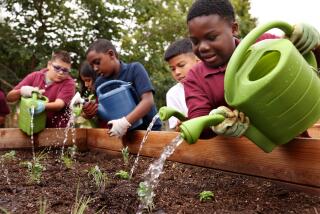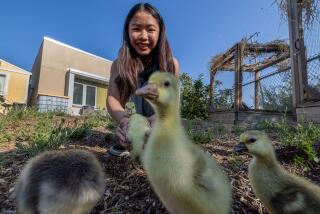2nd-Graders’ Seeds Sown for Solace
You attend Mrs. Moore’s second-grade class, you do time in the garden.
That’s just how it is.
Every fall, as sure as the start of a new school year, you gather thousands of tiny seeds from hollyhocks, sunflowers, sweet peas, larkspur, Oriental poppies. You paint little envelopes for them, and Mrs. Moore peddles them at 50 cents a packet in places like Nordstrom and a fancy little shop in West L.A. The profits go back into the garden, so next year’s crop of kids can also chop dirt, lay down compost, plant, harvest, weed, and do everything a real farmer would do except lobby for price supports.
But not even Mrs. Moore, who lives on a farm and pickles her own beets, knew what would become of the seeds scattered to the four winds of commerce. Who could have predicted that a few of her second-graders’ seeds might bring a little hope to distraught Kosovo refugees? And if flowers couldn’t bring hope, what good would they be?
Mrs. Moore--her friends call her Jinny, short for Virginia--teaches at Saticoy Elementary School in Ventura.
For eight years, she’s had a garden there, where the kids in her classes grow flowers and vegetables. It’s a smaller version of her garden at home, which happens to be a 60-acre biodynamic farm in the rolling hills outside Carpinteria.
“Biodynamic” is not a term made up by Jinny Moore or her husband, Stephen. It’s a kind of organic farming devised in 1924 by Rudolf Steiner, an Austrian visionary. Revered in some quarters and ridiculed in others, Steiner prescribed some amazing additions to compost: chamomile buried in a cow’s intestine, yarrow blossoms aged in a stag bladder, a sheep’s skull filled with oak bark and buried beside a stream. Believers swear these and other biodynamic techniques make plants more vital.
Sometimes Jinny Moore’s students visit the farm. They make fresh lemonade, they cut and dry persimmons, and they get close to real vegetables--a mighty leap for children who might view the corn dog as a product of Mother Nature.
“I’ve had kids who have never tasted lettuce,” marvels Jinny Moore.
Over the years, her classes’ seed enterprise has thrived. Parents have signed on, too, volunteering to laminate the seed packets and help sell them.
This year was the biggest yet. A teacher at a private school in Boston--a fellow believer in biodynamic farming--bought hundreds of the Saticoy School’s seed packets for a fund-raiser of her own.
Gardens throughout the land of the bean and the cod are now sprouting a bit of Saticoy. The Boston teacher grew dozens of sunflowers from her stash of seeds and donated them to the House of Peace, a haven for refugees in Ipswich, Mass.
“I planted them along the whole front of the house,” said John Shuchardt, founder of the House of Peace and an activist who has taken in refugees from El Salvador, Bosnia, Albania, Eritrea, Iraq and elsewhere.
In season, the fields of Yugoslavia blaze with sunflowers, he said.
That might be a small solace to the family of seven Kosovars now in limbo at the House of Peace--unable to speak English, uncertain of what their future holds, yearning to return to their ruined home in Pristina.
“The grandfather cries and cries,” Shuchardt said. “Tears flood down his face day after day.”
The rambling white house was built in 1727, and these aren’t its first sunflowers. But they’re the first that started their lives in the second grade at the Saticoy School and, given a little care, they’ll remain a small solace for the next batch of refugees from the world’s next hellish killing ground.
“Wow,” Jinny Moore said. “That kids could do something that would reach this far.”
Steve Chawkins is a Times staff writer. His e-mail address is steve.chawkins@latimes.com.







